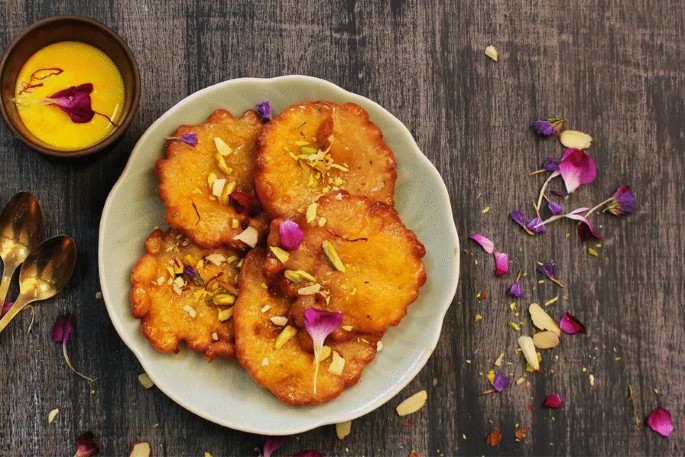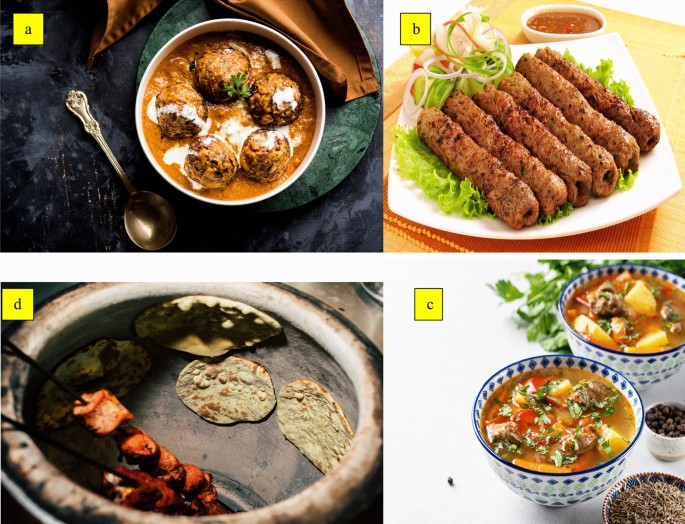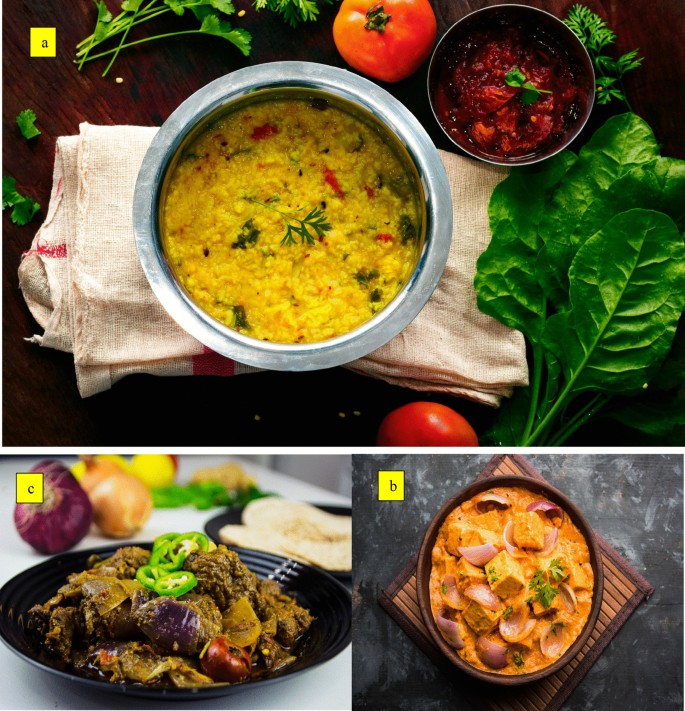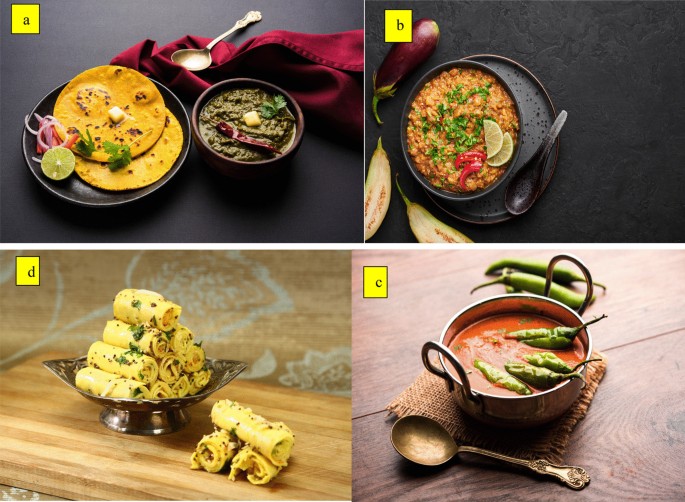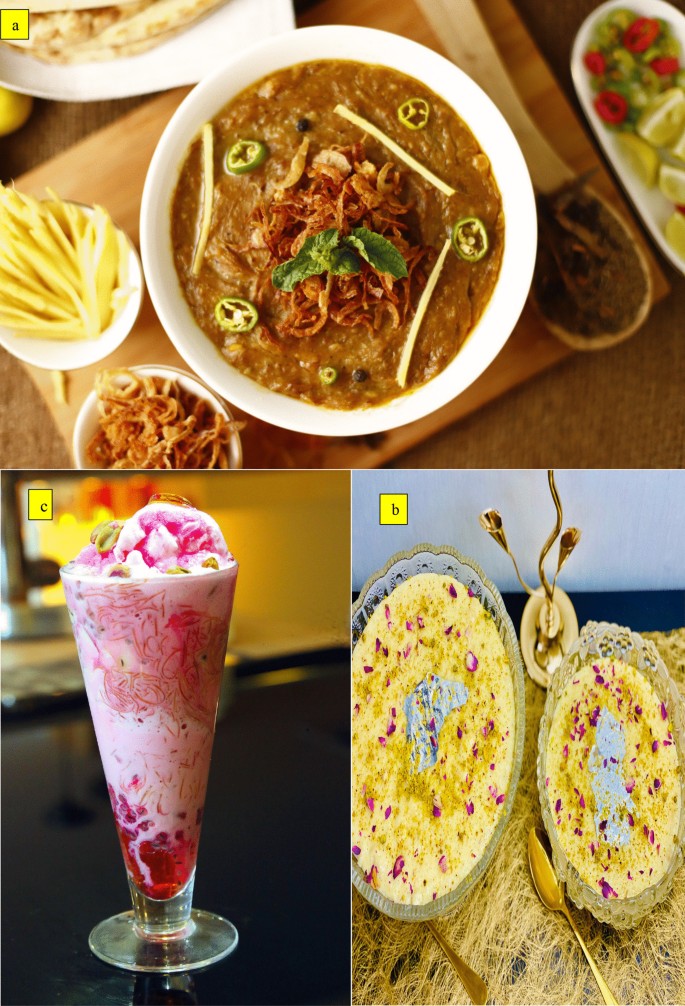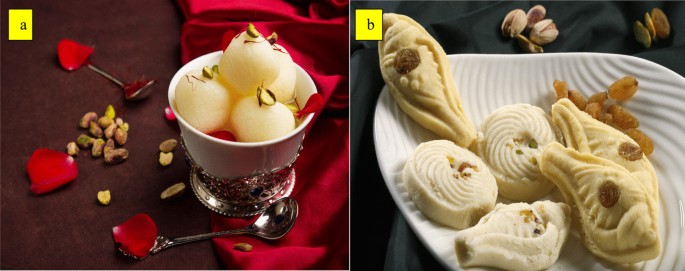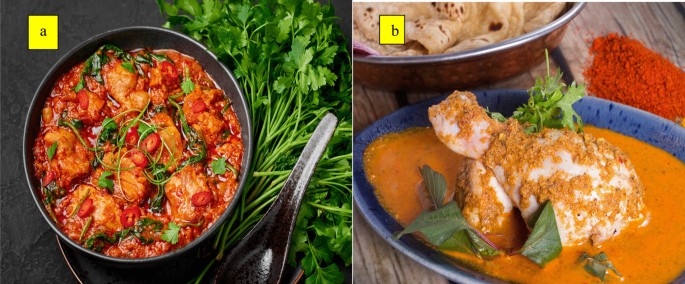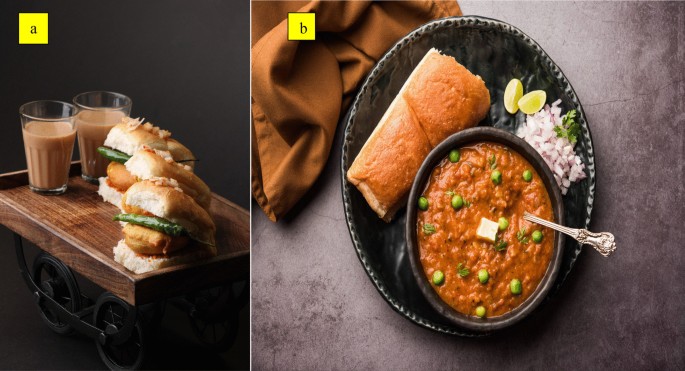- Original article
- Open access
- Published:
Evolution of Indian cuisine: a socio-historical review
Journal of Ethnic Foods volume 9, Article number: 15 (2022)
Abstract
This paper aims to present a socio-historical review of Indian cuisine and its evolution. Based on a thorough analysis of a wide range of documents, the investigation focuses on four eras, each having a significant and lasting effect on Indian cuisine. Parallels have been drawn to modern Indian cuisine wherever possible. This study follows the advances in Indian cuisine through the prehistoric era, into the Vedic era, where religious scriptures, especially the Hindu scriptures, affected what was cooked during the time, followed by the invasion of the subcontinent by the Mughals. Finally, the effects of European colonization on Indian cuisine are critically analysed and an attempt is made to examine threads, if any, connecting culinary preferences of people across these phases. The results of the analysis indicate the intriguing impact of intricate connections among several sociocultural factors on the evolution of Indian cuisine. At the end of the paper, a few areas are identified for future exploration.
Introduction
This paper tries to trace the history of Indian cuisine, a topic that remains surprisingly underexplored in the gastronomy literature. Unique in its standing and mysterious in many ways, as claimed by the famous novelist E. M. Forster [20], India remains a curious case of interest. Among other things, its food culture has a vibrant history filled with tasty twists and turns, which is in agreement with the claim that Indian culture can be explored through its foods. In fact, across many cultures, one can historically trace sociocultural reasons behind culinary choices [1]. Tracing the history of food in India is pivotal to understanding Indian cuisine. For a very long time, each of India’s conglomeration of kingdoms had a royal court tended by chefs and innovations in food took place in these kitchens; new dishes were created, and old dishes were recreated. In the kitchens of commoners, cooks or housewives would try to recreate those dishes using ingredients at their disposal. Modern Indian cuisine is the result of the flavourful adventure India has been through, and in this adventure, one can socio-historically trace the interaction between personal and social choices, the divine and the mundane obligations [8], and the karma and its repercussions. The beginnings of India’s food history, especially during Vedic times, were driven by the attributive property of Guṇa, a Hindu philosophical concept referring to quality or peculiarity. Sattva, rajas, and tamas, the three Guṇas, were believed to have manifestations in the form of ‘vegetarian, spicy and carnivorous’ [6, 43]. Even the philosophy of ahimsa shaped the food choices of people in ancient Hindu civilizations [42]. This philosophical tradition underwent a series of changes, challenged by the geopolitical and sociocultural changes that came to India with the Mughal invasion and European colonization. In this paper, we have presented a brief historical review of Indian cuisine that covers a period starting with the prehistoric era and ending with European colonization and have demonstrated how the evolution of food in India is deeply enmeshed in various factors like culture, religion, ethnicity, financial background, social class, and availability of and access to raw materials.
Methodology
We collected data for the study through thorough document analysis. We surveyed ancient religious scriptures from archives, newspapers, memoirs, travelogues, research articles, poems, history books and books written on food cultures, and made comprehensive notes. All the notes were verified through information collected from more than one source. Then, we searched for patterns in the data and organized the details under the four most frequently found patterns in food culture: Prehistoric, Vedic, Mughal, and European colonization. For each era, we arranged the information in a systematic manner which mainly focused on discussions on the evolution of food through a close interplay between sociocultural factors and the availability of raw materials required for the preparation of food.
Results and discussion
Prehistoric era
Prehistoric food habits in India still remain partly shrouded in uncertainties [33]. Like literature, cuisines from a different era have proved difficult to understand. Written recipes may be one of the sources of determining the type of food eaten by the people then, but language still remains a barrier [11, 16, 32], which is especially true in the case of prehistoric India. What we know about people’s food habits is an episodic story of survival and a transition to becoming an agrarian community [33]. The information is obtained through anthropological evidence and cave paintings found in various parts of Indian states such as Rajasthan, Gujrat and Punjab [1].
Bones of cattle, goats, sheep, buffalo, and pigs have been found at Harappan excavation sites. While cattle, goats, and sheep may have been domesticated, it is also possible that they were hunted or raised for their flesh. Cattle farming was mainly restricted to the Zebu cattle, native to the Indus Valley region (see Fig. 1) [21]. Bones of wild animals like boar, deer, and gharial have also been found. Along with these, the remains of fish and fowl were also discovered. Grilling was the preferred way to cook meat. The animal would be roasted whole on an open fire or cut into bite-size chunks [33, 35, 36]. These chunks were pierced onto a skewer and roasted, like modern-day tikkas. The animal was lodged onto a stick, which could be rotated, and placed over the fire. Pottery from prehistoric times has revealed the presence of bowls with wide mouths, which indicates the use of boiling as another method of preparation [24].

Source: Wikimedia Commons https://commons.wikimedia.org/wiki/File:Indus_Valley_Civilization,_Mature_Phase_(2600-1900_BCE).png
A map of the Indus Valley Civilization dating back to 2600–1900 BCE. It was a Bronze Age civilization and one of the most widespread civilizations in Asia, spanning modern-day north and north-western India, most of Pakistan and Afghanistan.
Pulses and grains were consumed by the people of the Indus Valley [23]. Various pulses like chickpeas, red lentil, and green peas were introduced from Western Asia to the Indus Valley in around 4000 B.C. Barley and wheat were also found along with the pulses at archaeological sites. Their use carried over into the Vedic era, when barley was one of the primary grains. Rice was consumed much later.
Several stone tools of varying sizes have been discovered at excavation sites. Large saddle querns have been found, probably used for grinding grains to make flour. Two types of stones may have been used with the querns: a small one for rolling, like a rolling pin, and a larger, heavier one to pound on materials. Curry stones would have been used to grind spices. However, it remains unclear whether the spices were grown within the region or obtained through trade or barter.
Vedic era
Many important texts on medicine, yoga, literature, religion, etc., from the Vedic era, such as Patanjali’s Yoga Sutras, Caraka’s Caraka-Saṃhitā, and the Upanishads, have discussed foods and their impact on the human body. The Vedas have emphasized the connection between spirituality and the choice of food without relinquishing the need for taste and health [27]. Recent research throws light on linguistic similarities of food items consumed across cultures making it slightly easier to connect the finer dots of Indian cuisine from the Vedic era [1]. The decline of the Indus Valley Civilization was followed by the Vedic period. During this period, the north-western region of the Indian subcontinent was occupied by Indo-Aryans. Most of the Aryans then were pastoralists. Milk provided for their food and other products like butter and curd.
The Aryans considered food to be a gift from God and a source of strength. In the four Vedas, Rigveda, Samaveda, Yajurveda, and Atharvaveda, there are various mentions of the grains used during those times [38]. Initially, barley was a staple food of most Aryans. Cultivation of other crops such as wheat, sugarcane, and millets followed. Lentils, mainly red, green, and black, were also grown. Later, the Aryans added rice and other cereals to their diet [13].
Sweetcakes called apupa have been mentioned multiple times in the Vedas. Apupa or Malpua (see Fig. 2), as it is called today, was made with barley flour. The batter would be flattened into cakes and fried in ghee. Before serving, the fried cake was dipped in honey. Many variations have developed over time, and malpua is now paired with various condiments. Today, the batter is made with refined wheat flour or semolina flour and milk. Like the Vedic version, the batter is spread into flat cakes and fried in ghee. Instead of honey, the cakes are soaked in sugar syrup flavoured with saffron or jaggery (cane sugar) syrup. They are topped with chopped almonds and pistachios and paired with rabri, a sweet made by boiling milk at low heat with sugar and spices.
Malpua and Rabri: Malpua is an Indian sweet fried pancake, made from a batter of wheat or barley flour. It is fried in ghee and then placed in sugar syrup. Souce: Shutterstock https://www.shutterstock.com/image-photo/malpua-traditional-indian-sweet-pancake-coated-1035620161
Fried barley called dhana was not just eaten as food but was also offered to the gods. Pulverized barley seeds, called saktu, have been mentioned in the Vedas. Sattu, a flour made from ground pulses, is used in many kitchens today, and it may have roots in saktu. A porridge called odana was made by boiling barley in milk. Yet another preparation called karambha had yogurt mixed with barley, and it is still popular in parts of Gujarat.
Animal meat was presumably used by Hindus in what is now Punjab. Cows, goats, buffalo, and bulls were killed for their meat, and slaughterhouses have been mentioned in the texts. The practice of eating horse flesh was introduced by the Aryans, but its consumption did not seem to settle well with the natives. However, there have been accounts of slaughter of cows and bulls for their meat [24]. Meats were mostly roasted in clay ovens or on spits over charcoal. The consumption of meat as a survival strategy can be contrasted with the current debates about meat eating and its consequences [46].
Sesame seeds were important as both food and in rituals. As food, they would be cooked with vegetables, added to bread, or crushed to extract oil. Turmeric, pepper, and mustard seeds were used as flavourings. Various fruits and vegetables are mentioned in the Vedas including the bael fruit (Aegle marmelos), mangoes, dates, lotus stalks and roots, gourds, jujubes, and water chestnuts. These are not very different from the ingredients used in Indian kitchens today.
Alcoholic beverages existed in Vedic times, as suggested by the mention of sura in the Rigveda but disapproved for consumption. The drink has been mentioned only in a few places, and at times, in conjunction with soma. Soma was considered the drink of Gods and an elixir. The plant from which the drink was made has remained a mystery, but historians have speculated candidate plants [34]. It could be a type of millet, called ragi. Ragi is still used to make marua, an intoxicating drink in the Eastern Himalayas. Cannabis could also be the plant referred to in the texts which was used for preparing the soma drink [4]. Yet another suggestion is the fly agaric mushroom, because of its intoxicating effect when consumed [51]. Soma was prepared and offered to gods by Brahmans [17]. It is unclear as to whether or when fermentation took place [19]. There is debate surrounding the effects of soma [7]. While one branch of research views the description of the drink in the Vedas as intoxicating, other researchers argue that it was simply exhilarating, not intoxicating [44].
An important aspect of the social system in India that determined food culture and consumption among Indo-Aryans was the caste system [40] which can be traced back to around 1000 BC. The structural embodiments of the caste system, a legitimised practice of inequity believed to be inherited through one’s parentage and occupation, engendered a sense of purity in the culinary and consumption habits of people. Brahmins, the upper caste priests, often adhered to vegetarian food habits led by the philosophy of sattva. In contrast, Shudras, the lowest group in the caste ladder, engaged in eating animal meat and other kinds of tamasic habits. The possibility of upper caste politics to portray certain kinds of food habits as superior to others could be indeed the case. It is possible that the caste system was strengthened with the help of systemic food demonisation. Unfortunately, the caste system continues to shape food habits even in present times [39].
The descriptions about the culinary culture around 500 BC are not separately dealt with in any treatises as such. Rather, one can find these details in the memoirs of foreign writers and philosophers who visited India during those times. Megasthenes, an ambassador of Alexander and Chinese visitors such as Fa-Hsien and I-Ching, and Xuan Zang, a learned monk from China, have vividly described sociocultural practices including food and drinks [1].
Mughal era
Muslim rulers who were based in Sind (currently in Pakistan) started invading India after 700 AD with a desire to have access to the material riches the country possessed. In the consecutive millennia, continual attempts were made by several warlords such as Mahmud of Ghazni, Muhammad of Ghor, Bakhtiyar Khalji, and so on. However, no Muslim empire could flourish and sustain till Mughals came to India in the sixteenth century [22]. With Mughals came a flood of culinary inspirations and innovations that remain highly influential in the culinary practices of India [29]. Indian food culture, much like architecture, art, music, and language, would be unthinkable without considering the Mughal influence [10]. The predecessors of the Mughals, the Afghans, had brought with them a lot of culinary wealth. Afghan flatbreads, called naan, are now common in most Indian households and restaurants. These breads may bear some influence of Egyptian and Mesopotamian breads [12, 15, 30]. Koftas in Afghanistan are meatballs of minced beef flavoured with onions and other spices. Indian koftas are very similar to their Afghan counterparts, but beef is often replaced with other meat. In the southern and eastern regions of India, koftas are made from fish and shrimps. The meatballs are then served in gravy made of broth, milk, and cashew paste. A vegetarian version of the dish replaces the meat with grated vegetables or paneer. Jalebi (see the details in Fig. 3) is an Afghan dessert that has placed itself so well in Indian cuisine, that most people often forget its origin. Jalebi is made by frying a batter of refined flour in ghee or oil and then soaking it in sugar syrup, which is often infused with saffron giving jalebi its colour and fragrance. It is served simply with rose petals or alongside rabri. Phirni is one of the recent additions of an Afghan dish into Indian cuisine and is made by boiling soaked rice in milk along with nuts and khoa.
Jalebi is a dessert made by deep frying flour batter in concentric shapes and later dipping in sugar syrup infused with saffron. It is enjoyed across the Indian subcontinent and is known by different names in different places. Souce: Shutterstock https://www.shutterstock.com/image-photo/jelebi-cafe-458778184
Mughlai cuisine, with its rich and spicy curries, and fascination with meat has been influential in shaping modern Indian cuisine. It is important to note that most of the ingredients present in the dishes which masquerade themselves as Mughlai dishes, such as chillies, tomatoes, and potatoes, were unknown to kitchens in India until the late seventeenth or early eighteenth century [28]. This is the effect of modernization and innovation in the culinary world. Memoirs of rulers, like the Baburnama and the Akbarnama, hold a lot of information about food and eating habits [48]. Manuscripts of what seem to be recipe books written in Persian have also been found.
Since the Mughals practised Islam, pork was forbidden in royal courts and to other Muslims. Similarly, Hindus frowned upon the consumption of beef and refrained from eating it. The meat of a buffalo seemed the appropriate replacement for beef. Mutton and goat meat were widely consumed, mutton being more common than the latter. Various fowls such as chicken, quail, and ducks were also consumed [50]. Even today, mutton and fowl meat are the most common meats eaten in India along with seafood like fish and shrimp though politics has not left food alone. In Mughal times, Akbar, the most powerful and influential among Mughal emperors, avoided repeating the mistake of using cows as food which his father Humayun did. Humayun’s men ate beef and that incited Rajputs, the Hindu royal class. Akbar went to the extent of becoming a virtual vegetarian [40] to please Hindus and maintain his supremacy. However, the emperors that succeeded Akbar could not play the politics of food as wisely as Akbar did.
Mughlai food has a distinct bouquet associated with it. This aromatic aspect of food is brought about by the spices used. Spices were traded between Mughals and other rulers in India. Cumin and coriander were and still are common across India and were probably grown locally. Saffron, a very expensive spice, known for its sweet floral scent was imported from Kashmir. Other spices that added heat like cardamom, pepper, nutmeg, and ginger were brought from Southern India near the Malabar Coast. Turmeric was also brought from there. Interestingly, these regions still maintain a very high quality in producing the spices.
One of the earliest accounts of Mughal cuisine is recorded in the Ni’matnama (the Book of Delights). It was a cookbook compiled by Ghiyath Shah, the Sultan of Malwa, in the fifteenth century. The manuscript is believed to have found its way into the Mughal kitchens in 1562, when Akbar conquered the Malwa Sultanate. The book has detailed recipes, accompanied by miniature illustrations where the king is the central figure of the drawings and notes following dishes, classifying them as being worthy to be served to a king, a poor man’s food, or a king’s favourite. In the Ni’matnama, there are recipes for a variety of sambusas. Sambusas are made with a pastry of refined flour, then filled with a savoury, spicy filling, and finally fried. The filling of sambusas was made from venison [49]. In samosas (see Fig. 4), a modern-day favourite, the filling is made up mainly of potatoes, peas, and onions. Samosas continue to be a crowd-favourite tea snack in modern India.
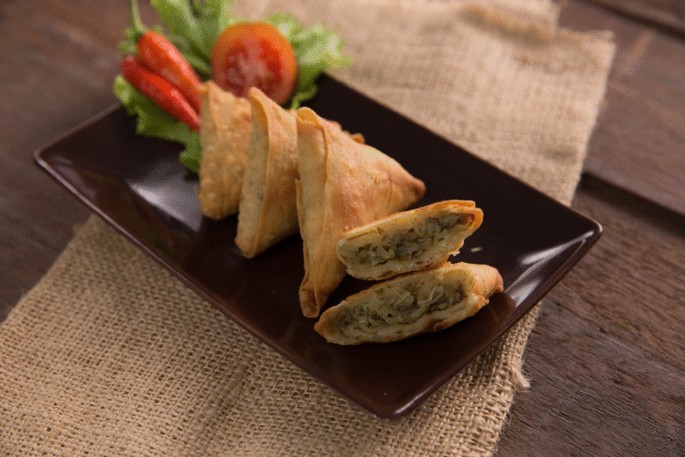
Souce: Shutterstock https://www.shutterstock.com/image-photo/samosa-sambusa-triangle-fried-baked-dish-1145803784
Sambusas or Samosas are snacks made by frying pastry filled with a savoury filling such as potato, peas, onions, chicken, or lentils. They are one of the most popular tea time snacks in India.
Karhi is a preparation of chickpea flour with yogurt and sour milk which has been mentioned in the Ni’matnama and is still made in a lot of Indian houses. It is served with fried vegetable fritters, called pakoras. The Guajarati variation of karhi is sweetened by adding sugar or jaggery.
A number of dishes mentioned in the Ni’matnama point to Central Asian influence in the food. Sambusa is an example of that. Other such dishes include sikh, kabab, yakhni, shurba, and kufta. Sikh is a cylinder of spiced minced meat on a skewer which is roasted on a tandoor. Yakhni is broth made with spiced meat, while shurba is soup.
Several dishes mentioned in the Ni’matnama, sambusa, sikh, kabab, yakhni, shurba, and kufta (refer to Fig. 5a), point to Central Asian influence. Sikh (refer to Fig. 5b) is a cylinder of spiced minced meat on a skewer which is roasted on a tandoor (refer to Fig. 5d). Yakhni is broth made with spiced meat, while shurba (refer to Fig. 5c) is soup. Apart from the common spices, a variety of exotic aromatics were used, such as musk (nutmeg), camphor, rosewater, and ambergris. The use of exotic produce was not limited to aromatics [49]. Recipes included in the book called for the use of a variety of unique meats, like partridges, rabbits, goats, mountain sheep, pigeons, and quails. Some of these meats are not common in modern Indian kitchens. The use of nutmeg is still prominent in Indian cuisine, but ambergris is obsolete.
a Malai Kofta is a dish made by adding fried balls of potatoes or meat in a rich spiced tomato gravy, topped with fresh cream. Souce: Shutterstock https://www.shutterstock.com/image-photo/malai-kofta-mughlai-speciality-dish-served-1248493381b Sikh kebab is an Asian preparation where ground lamb or beef meat is wrapped around skewers and roasted on an open flame. Souce: Shutterstock https://www.shutterstock.com/image-photo/seekh-kabab4-154602104c Shurpa or Shorba is a soup made with meat, vegetables, and spices in broth. Souce: Shutterstock https://www.shutterstock.com/image-photo/shurpa-shorpa-soup-rich-lamb-vegetables-1875768625d Tandoor is a traditional Indian oven, used to cook naan and tikkas. Souce: Shutterstock https://www.shutterstock.com/image-photo/tandoor-oven-tikka-masala-chicken-naan-1854698554
Rice became more popular than wheat during Mughal times. Khichri is one of the many preparations of rice mentioned the Ni’matnama [49]. It is a salty porridge made from rice and lentils, usually without spices. The preparation and ingredients used in khichri vary with region, and a lot of varieties of khichri can be found in homes all over India. Since it is nutritious and easy to digest, it is often fed to the ill. The Ni’matnama was not the first historical account of khichri. Selecus, when he was the infantry general to Alexander the Great, revealed that rice with pulses was extensively prepared in India, around 300 B.C.E. Further, it is also mentioned by Ibn Battuta as kishri from his stay in India in approximately 1350. In his description, kishri was a rice dish with mung beans (green gram). Afanasy Nikitin, a Russian merchant and one of the earliest Europeans to travel to India, has described khichri in his narrative—Khozheniye za tri moray (The Journey Beyond Three Seas). Khichri (refer to Fig. 6a) was popular during the Mughal period, especially under Jahangir [47]. Ain-i-Akbari, by Abu’l-Fazl ibn Mubarak, mentions seven variations for khichri. There is also mention of the dish along with biryani in the letters of Aurangzeb to his son, Bahadur Shah I.
a Khichdi is a savoury rice porridge with the addition of lentils, vegetables, and spices. Source: Shutterstock https://www.shutterstock.com/image-photo/famous-indian-food-khichdi-ready-serve-1629680485b Paneer do pyaza is a made of Indian cottage cheese and rich onion-based gravy. Source: Shutterstock https://www.shutterstock.com/image-photo/paneer-do-pyaza-popular-punjabi-vegetarian-1263154453c Mutton do pyaza is made of lamb meat and seasoned with lots of onions. https://www.shutterstock.com/image-photo/mutton-do-pyaza-two-onions-1226282581
Nushka-i-Shahjahani or Nushka u Namak is another cookbook that has recorded the recipes prepared in the kitchens of the emperor Shah Jahan—from breads and stews to sweetmeats. The ten chapters on food describe the varieties of breads, pottages, meat dishes, and other rice preparations like pulao and zerbiryans. Among the breads, there are recipes for naan (leavened oven-baked flatbread) and roti (round flatbread made from wholemeal flour), but no mention of paratha, a flatbread made of layers of cooked dough (hence, paratha was a later addition to Indian breads). Meat dishes were of two categories: qaliyas and do pyazas. Do pyazas (refer to Fig. 6b and 6c) got their name from the preparation, where piyaz (onion) is added twice (do) in the process. Kebabs, porridges, and omelettes are also mentioned. The end of the collection features preserves like jams and pickles, fried breads, sweets, and puddings. Finally, a few basic techniques for making yogurt and cheese curds are included. Paneer (or Panir) is an example of a cheese that is extensively used in Indian cooking, especially in vegetarian dishes as a protein source. The cheese curd for Paneer is made by curdling milk with a fruit- or vegetable-based acid (like lime juice).
Khulasat-i Makulat u Mashrubat or Alwan-i Ni’mat or Khwan-i Alwan-i Ni’mat is a cookbook from the times of Aurangzeb’s reign. It has forty chapters, each describing a category of a course, including nan-ha (breads), qaliya and do pyaza (meat curries), sag (greens, refer to Fig. 7a), bharta (mashes, see Fig. 7b), dal (pulses and lentils), zerbiryan (layered rice dish), khandawi (savoury cakes made from pulses or gram flour, refer to Fig. 7d), salan-ha-i hindi (sauced-based dishes of India), khichri, shola (dish with rice, meat, pulses and vegetables), kulthi (sweet sticky rice), thuli (sweet thick preparation with milk and flour), tahiri (rice and meat dish), halim (meaty stew made with wheat and barley, refer to Fig. 8a), kashk (gruel with wheat and meat), ash (pottages), bara (fried cakes), jughrat wa sikharn (yogurt based dishes), shirbirinj (rice pudding of Iranian origin, refer to Fig. 8b), firni, faluda (a cold dessert made with milk, rose syrup, vermicelli and basil seeds, refer to Fig. 8c), panbhatta (a dessert made from fried soaked rice in sherbet), sambusa, puri (fried bread), gulgula and khajur (sweet dumplings), malida (sweet powdery mixture made of dough), shirni (sweetmeats), murabba (jams), and achar (pickles). In addition, there are chapters on basic activities, like shelling coriander. A lot of the dishes are drawn from the earlier cookbooks, notably the breads, meat curries, rice dishes, khichri, and jams and pickles. From the unique preparations mentioned in this book, sag, khandawi, salan, shirbirinj, and phirni are common preparations in Indian kitchens today. Dal has become a staple, especially in vegetarian households as a protein source. Salan, specifically mirchi ka salan (a curry of chillies in peanut gravy, refer to Fig. 7c), is served with biryani. Faluda has also been popularized and is made on special occasions. It is usually topped with ice cream, and a particular variation calls for the addition of jelly cubes in the sherbet.
a Sarson ka sag with makki ki roti is a special preparation in the north of India, eaten during winters. The curry is made of mustard greens with sauteed onion and garlic. Makki ki roti is basically a flatbread made with ground corn. Source: Shutterstock https://www.shutterstock.com/image-photo/makki-ki-roti-sarson-ka-sag-774826045b Baingan ka bharta is mashed roasted eggplant that is then sauteed with onions, chilli and spices. Source: Shutterstock https://www.shutterstock.com/image-photo/baingan-bharta-roasted-mashed-eggplant-black-1837782358c Mirchi ka salan was a popular dish in the Mughal kitchens, eaten with rice preparations. Even today, mirchi ka salan is served with biryani across the country. Source: Shutterstock https://www.shutterstock.com/image-photo/hyderabadi-mirchi-ka-salan-green-chilly-1494080111d Khandavi is a snack from Maharashtra and Gujarat made by rolling sheets of steamed batter of gram flour and yogurt into bite-sized pieces. Source: Shutterstock https://www.shutterstock.com/image-photo/khandvi-gujarati-patuli-dahivadi-suralichi-vadi-1460691638
a Halim is a slow-cooked stew made up of grains, meat and lentils. It is eaten to break fasts during the month of Ramadan owing to its high nutritional value. Source: Shutterstock https://www.shutterstock.com/image-photo/haleem-spices-herbs-1488278681b Sher Birinj is a dessert originating in central Asia. It is a rice pudding flavoured with rose water, almonds, cinnamon and cardamom. Source: Shutterstock https://www.shutterstock.com/image-photo/pudding-shir-berenj-afghan-delicious-dessert-1956784180c Falooda is an Indian dessert made with rose syrup, milk, vermicelli noodles and sweet basil seeds, topped with ice cream. It is commonly sold on the streets by vendors in India. Source: Shutterstock https://www.shutterstock.com/image-photo/pink-sweet-strawberry-falooda-1779708683
Today, cities like Delhi, Lucknow, Kolkata, and Hyderabad boast the best Biryanis. There are a lot of similarities in its preparations across the country—the use of nutmeg, cinnamon, cardamom, and cloves for aroma, adding saffron to colour the rice, and the flavour developed by cooking meat and vegetables with rice. Despite similarities, the differences are evident. The Hyderabadi Biryani is a spicy preparation, made with Basmati rice, which adds to the aroma, and the flavours of saffron and coconut dominate. It is served with brinjal (eggplant) gravy. The Kolkata Biryani also uses Basmati rice and saffron, but it is the use of meat and ghee (clarified butter) that defines the taste. Potatoes and boiled eggs are also added. The Lucknowi Biryani does not use Basmati rice and uses a paste made from curd and cashew nut along with the aromatics like star anise and nutmeg. The flavour of saffron is not as pronounced, and the Lucknowi Biryani is served with meat gravy.
Mughals ruled the majority of Northern and Northwestern India, but their dominion was not as powerful in Southern India. However, this did not affect their cuisine from spreading into the south. Nobles from courts of Nawabs and other rulers of Southern India travelled to cities under the Mughal rule as diplomats and brought back with them accounts of food eaten and, sometimes, the recipes. The Mughal dishes made in Southern India often had a different set of ingredients or different methods of preparation.
Modern Indian cuisine has incorporated many dishes from Mughal kitchens. With the Mughal invasion, there was an increase in the consumption of rice, which has led to a decrease in dependency on wheat. As a result, rice has become the staple crop in India and Indian cuisine lacks identity without it. Mughals also introduced a wide variety of desserts and sweetmeats. India boasts a wide range of milk-based sweets and desserts, and most of these dishes originated in the Mughal times. Hence, the Mughal era was arguably the time that shaped Indian cuisine as it is today.
European colonization
When Mughals were reigning most of India, the Portuguese slowly started building their colonial empire. Unlike Mughals who intended to own the land and live here, the Portuguese wanted to send profits to their homeland. Spices were one of the main reasons that the Europeans sought a sea route to the Indian subcontinent. It was a powerful product in the trade market, and establishing trade with India was deemed necessary. However, the opulence and wealth of kings and the royal class changed their intentions and colonisation became a priority over trade [9].
In 1498, Vasco da Gama reached the Malabar Coast of Calicut, a bustling port where the trade of spices, cloth, and a variety of extravagant goods took place between Hindu, Arab, and Chinese merchants [12]. As the Portuguese Empire expanded, trade of plants, animals, and ideas became common at ports. This was called the Columbian Exchange and was paramount in shaping the cuisine of various regions [5]. In 1510, after seizing Goa, they made it their capital of Estado de India (State of India). Soon after, spices were grown all along the Malabar Coast for trade. A lot of customs and traditions of Hinduism and Islam were questioned and eradicated [31]. Those that could not be eliminated were banned. They questioned the refusal of eating pork and beef and introduced a variety of dishes cooked with those meats. They also did away with the Hindu tradition of cooking rice without salt. Growing tulsi (holy basil) was banned.
Cheese was introduced to India by the Portuguese. Bandel cheese is a smoked semi-soft cheese made from cow’s milk. It has a dry, crumbly texture and is one of the very few Western-style cheeses indigenous to India. Another creation of the Portuguese in India is the cheese curd called chhana [26]. However, it has been argued that the practice of curdling milk had been practised earlier. There is little doubt that a Portuguese cheese similar to chhana was the inspiration for a variety of Bengali sweets like rasgulla and Sandesh (refer to Fig. 9a and b) [41, 42]. Rasgulla is a ball-shaped dumpling made of semolina dough and chhana, which is boiled in light sugar syrup till the syrup steeps into the dumpling. They are then stored in sugar syrup, often flavoured with saffron strands or rosewater [45]. Rasgulla is known as Rasagola in Odisha, another state in the eastern part of India, and recent research also indicates that Rasagola was prepared in Jagannath Temple in Odisha in the thirteenth century AD. Sandesh, a sweet dish, has been mentioned in medieval Bengali literature, including Krittibas’ Ramayana, but the original dish was most likely very different from the current version. The modern-day Sandesh is presumably made with chhana cheese, but there are other preparations of sandesh without chhana, with just milk and sugar. Normally, sandesh is made by tossing chhana in sugar over low heat. In some cases, use of khejur gur [3] as a sweeter has been mentioned.
a Rasgulla is a Bengali/Odia sweet made of dumplings of chhena and semolina flour and cooked in sugar syrup. Source: Shutterstock https://www.shutterstock.com/image-photo/bowl-full-rasgulla-pistachios-food-table-1338243359b Sandesh is a Bengali sweet made by moulding chhena and sugar in different shapes. It can be flavoured with saffron and cardamom and topped with chopped almonds. Source: Shutterstock https://www.shutterstock.com/image-photo/assortment-sandesh-traditional-bengali-sweets-prepared-279675779
The greatest gift to Indian cuisine by the Portuguese was perhaps the Columbian Trade which introduced crops like potatoes, okra, chillies, pineapples, papaya, cashew, peanuts, maize, guava, custard apples, and sapodilla. Tomatoes were not native to India and are believed to have been brought in through trade with other Asian empires, who in turn acquired them through trade with Spain. Most gravies in Indian curries today are tomato-based. Potatoes have been integrated into modern Indian cuisine as if it were a native plant [5]. India was the third largest producer of potato in 2007 at 26,280,000 tonnes and the third largest consumer at 17,380,730 tonnes in 2005, according to FAOSTAT, Food and Agriculture Organization of the United Nations [18]. Maize has also been adopted in Indian cuisine. Corn roasted on the cob is a popular street food seasoned with lime, salt, and red chilli powder. Certain west-Indian dishes call for kernels of corn in the recipes and cornflour is used to make a flatbread called makki ki roti (refer to Fig. 7a) in Punjab.
There is a strong Portuguese influence in Goan cuisine, and many preparations are adaptations of Portuguese dishes. The dish carne de vina d’alhos transformed to vindaloo (refer to Fig. 10a), which is a sweet and sour, but very spicy pork curry. Unlike the Portuguese preparation, vindaloo was made dry, so that it could be carried on long journeys. Caldo Verde, a Portuguese soup of potato and kale, is made in Goa with the same name, but is spicier, with the addition of ginger and black pepper. Also, kale is replaced by spinach in the soup. Xacuti Chicken (refer to Fig. 10b) is a Goan curry made with a paste of crushed peanuts, grated coconut, and a complex spice mix. A similar Portuguese dish is Chacuti de Galinha. The Portuguese also introduced a few types of breads, for example, the pau (oven-baked bread rolls). Many street foods across the country use pau today, like the vada pau (fried balls of mashed potato and spices served with different relishes in a bread roll, see Fig. 11a) and bhaji pau (tomato and potato-based tangy spicy curry served with bread roll roasted in butter, see Fig. 11b). Bibinca is a Portuguese baked dessert, where seven layers of cake made with flour, sugar, ghee, egg yolk, and coconut milk are stacked over each other to make a pudding. It is Goan tradition to make Bibinca at Christmas [42].
a Chicken Vindaloo is a spicy, aromatic Goan curry adapted from the Portuguese Carne de vinha d'alhos. Source: Shutterstock https://www.shutterstock.com/image-photo/chicken-vindaloo-spinach-black-bowl-on-1933658453b Chicken Xacuti is another Goan curry made with chicken, poppy seeds, toasted coconut shredding, black pepper, chilli, and other spices. Source: Shutterstock https://www.shutterstock.com/image-photo/chicken-xacuti-classic-dish-goa-region-1639569403
a Vada Pau is a famous Maharashtrian snack. It is a fried ball of spiced mash of boiled potatoes served in a bread roll with green chilli chutney, garlic chutney and fried green chilli. It is often eaten alongside chai (tea). Source: Shutterstock https://www.shutterstock.com/image-photo/masala-cutting-chai-bombay-vada-paav-1909642918b Bhaji Pau is another Maharashtrian street food made up of a spiced tomato and potato curry, served with bread rolls toasted on a pan with butter. Source: Shutterstock https://www.shutterstock.com/image-photo/pav-bhaji-fast-food-dish-india-396513787
Coloquios dos simples e drogas da India by Garcia de Orta, who served as the physician to the Portuguese viceroy to India, describes a lot of ingredients used in India. There are notes on pepper, banana, galangal, turmeric, betel, bhaang (preparation of cannabis, see Fig. 12), camphor, and asafoetida. He describes the excess use of asafoetida in India, especially in Hindu kitchens, and notes the extremely pungent smell of the dried latex of a Ferula herb [2]. The preparation of bananas involved roasting them and then serving them with wine and cinnamon. In another dish, bananas were cut in half, fried in sugar, and served with cinnamon sprinkled on top. The widespread use of bhaang was also noted adequately.
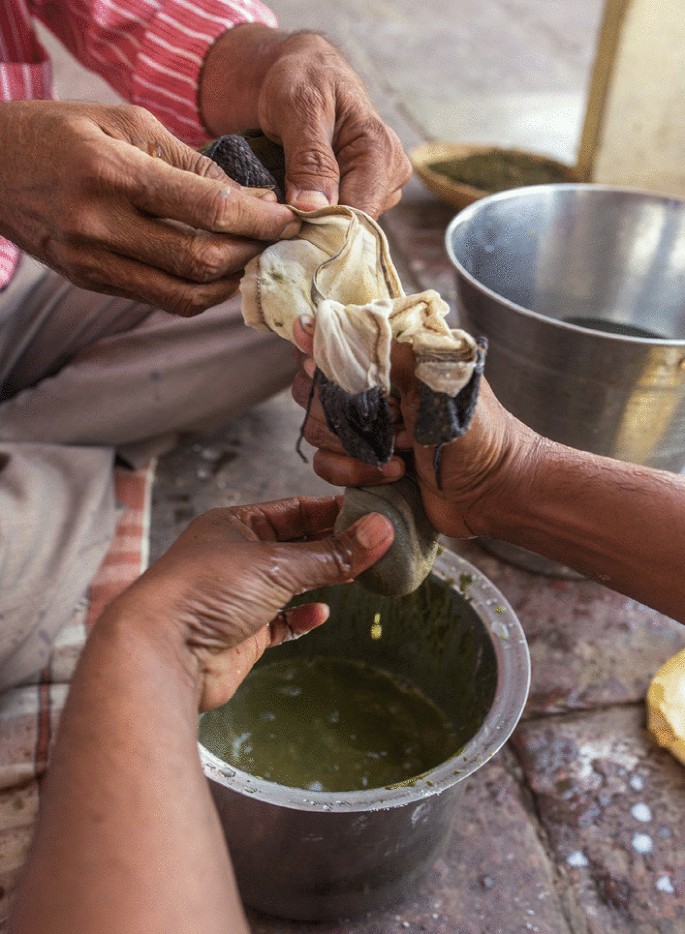
Source: Shutterstock https://www.shutterstock.com/image-photo/hindu-priests-prepare-bhang-milk-on-653747197
Bhaang being prepared by Hindu priests for consumption during the festival of Holi. It is prepared by crushing cannabis leaves with sweetened milk.
Following the Dutch entry into the trade market of the East Indies, the French established trade with India [50] and made Pondicherry their capital. Their legacy is visible in the local cuisine there. Ragout (a stew flavoured heavily with garlic and aromatics) and rum-soaked Christmas fruitcake are some of the French dishes incorporated in the cuisine of Pondicherry. Meen puyabaisse is a local preparation of the French dish Fish Bouillabaisse.
Like the previous colonisers, the British also started with trade intentions. They first docked at the port of Surat and this became their first trading establishment in India. This trade mainly involved the export of silk, sugar, salt, opium, and tea and the import of English products like ham, cheese, beer, and wine to supply the English population in India. After the decisive Battle of Plassey in 1757, the British managed to drive the French away from Bengal and laid a strong foundation for their future supremacy [14]. The British also overthrew the Dutch from Bengal in the mid-eighteenth century, and the thriving Dutch trade under Mughal patronisation came to an end [37].
The most notable effect of the British on Indian cuisine is found in the field of brewing. Taverns opened by the British served wine, beer, rum, and other British spirits. Punch was a popular drink served at such places. It was made by mixing five ingredients – arrack, rosewater, citron juice, sugar, and spices, resulting in the name paanch (means five in Hindi).
Beer, especially ale, was a popular beverage among the British in India. Later, the antimalarial properties of quinine were discovered and it was added to soda water, giving birth to tonic. It was paired with gin and served as gin and tonic at clubs. There are speculations that gimlet (gin with lime juice) was first made in India. The first brewery in India was established in the Solan District of Himachal Pradesh in 1830 and twelve breweries were established in India in the following fifty years.
The British were fond of tea and most of it was exported to England from the plantations in China. The British discovered tea growing as a wild plant in Northeastern parts of India where the locals used it in pickling and infused it in dishes. Tea plantations were then set up by the British in Assam, which spread to Darjeeling in the Himalayas, Nilgiri Hills in Southern India, and even to Sri Lanka. However, the drink was not common among the Indian population. It was only after the forced departure of the British that officials realized the surplus in fields that were previously farmed to export to Britain [19]. The Indians took their tea with milk and spices, which is now consumed today under the name chai. A similar story follows the cultivation of coffee in Southern India, but its growth was not as pronounced as that of tea, because coffee was mainly planted to meet the needs of locals.
The British also grew crops like oranges, carrots, cauliflower, spinach, and cabbage, which have found their way into Indian kitchens. Omelettes became famous as breakfasts served in clubs, where they would be made with minced onions and chillies.
As time passed and the British ruled over the country, Christian missionaries found a true mission in converting the Hindu population to Christianity. Several internal problems like the caste system, practices of untouchability, oppression of certain sections of the population, lack of access to health care, and so on opened the doors for conversion to Christianity. Along with educational and health care facilities, the converted Christians also started imitating English food habits. On the other hand, there evolved a community of Anglo-Indians who adopted most of the English practices and cultures. They have been attributed a distinct cuisine that involved preparing English ingredients in Indian ways [9]. Roasted beef, meat and potato curry, pepper water or rasam (spicy beef broth), jalfrezi (meat or fish stir-fried in a dry sauce along with vegetables), and dry fry (beef cooked with onions, tomatoes, and spices in very little oil) are some common dishes of the Anglo-Indian cuisine. Rasam and jalfrezi are popular in India even today. They also cooked Portuguese inspired Goan dishes like the vindaloo, balchow (meat or seafood cooked in spicy tomato chilli sauce), and foogath (vegetables sautéed with onion, garlic and mustard seeds) and celebrated Christmas with roast turkey or duck and plum pudding. In certain ways, Anglo-Indian cuisine was an introduction to pan-Indian cuisine.
Conclusion
The paper attempted to present a historical review of the diversity of food cooked in India. The paper is a small attempt at bringing together several scattered historical pieces of information related to how food evolved in India. While the pressure of not adequately providing ‘gastrosemantics’ [25], i.e. how a culture orchestrates the centralisation of food through a well-organized attempt to bring together the philosophy, consumption, beauty and transmission of food cultures, cannot be undermined, the satisfaction of making a shot at it is nevertheless immense. Not many mainstream journal articles are available on Indian Cuisine, and this study is by no means an exhaustive study of the History of Indian Cuisine. It is a fine line between risking oversimplification and focusing only on a certain era or a region, but that has been overcome here by focusing on a few decisive aspects of every era while keeping a note of developments elsewhere in the subcontinent. A few historical and philosophical aspects of the cultures associated with the history are highlighted to explain some of the culinary preferences and food habits. Future researchers can investigate some of the areas this paper has opened. As languages of the past begin being understood, it will be worth closely looking at manuscripts from the Vedic eras for culinary culture. From the understanding that religious practices often had a culinary aspect, studying the religion would inevitably teach us about the food and the ingredients available to the population. It would also be helpful to break the subcontinent down to meaningful regions and confine the study of the development of cuisine to particular regions. Lastly, since food politics in India has recently gained some research interest, it will be worth exploring how historically food politics has been played out in the country.
Availability of data and materials
Not applicable.
References
Achaya KT. The story of our food. Hyderabad: Universities Press (India) Limited; 2003.
Asafetida. Scientific American. 1857;12:152. http://www.jstor.org/stable/24952035. Accessed 12 Feb 2020.
Banerji C. A sweet fragrance in winter. Gastronomica. 2012;12:83–6. https://doi.org/10.1525/GFC.2012.12.1.83.
Bennett C. Cannabis and the soma solution. Waterville, OR: Trine Day; 2010.
Boivin N, Crowther A, Prendergast M, Fuller DQ. Indian Ocean food globalisation and Africa. Afr Archaeol Rev. 2014;31:547–81. https://doi.org/10.1007/s10437-014-9173-4.
Brill A. Rabbi on the ganges: a Jewish-Hindu encounter. London: Lexington Books; 2020.
Brough J. Soma and Amanita muscaria. Bull Sch Orient Afr Stud. 1971;34:331–62.
Brown P. Anglo-Indian food and customs. New Delhi: Penguin Books India; 1998.
Chazan M, Lehner M. An ancient analogy: pot baked bread in ancient Egypt and Mesopotamia. Paléorient. 1990;16:21–35.
Collier D. The great Mughals and their India. Hay House India; 2016.
Crosby AW. The Columbian exchange: biological and cultural consequences of 1492. Westport, Connecticut: Greenwood Publishing Group; 2003.
Crowley R. Conquerors: how Portugal seized the Indian ocean and forged the first global empire. Faber & Faber; 2015.
Dutt RC. From the earliest times to the sixth century BC. In: Jackson AV, editor. History of India. The Grolier Society, London, 1906
Edwardes M. The battle of plassey and the conquest of Bengal. Pickle Partners Publishing; 2017.
Ellison R. Some thoughts on the diet of Mesopotamia from c 3000–600 BC. Iraq. 1983;45:146–50.
Fairservis WA. The script of the Indus Valley civilization. Sci Am. 1983;248:58–67.
Falk H. Soma i and ii. Bull Sch Orient Afr Stud. 1989;52:77–90.
FAO (Food and Agriculture Organization). International Year of the Potato 2008, New Light on a Hidden Treasure. In: Food and agriculture organization of the United Nations. 2009. https://www.fao.org/3/i0500e/i0500e00.htm. Accessed 10 Mar 2020.
Fielder CH. On the rise, progress, and future prospects of tea cultivation in British India. J Stat Soc Lond. 1869;32:29–37.
Forster EM. A passage to India. Pearson Education India; 1969.
Gangal K. Models of the Neolithic dispersal in Southern Asia (Doctoral dissertation, Newcastle University). 2015. http://theses.ncl.ac.uk/jspui/handle/10443/2905.
Gommans JJ. Mughal warfare: Indian frontiers and highroads to Empire 1500–1700. London: Routledge; 2002.
Jarrige JF, Meadow RH. The antecedents of civilization in the Indus Valley. Sci Am. 1980;243:122–37.
Jha DN. The myth of the holy cow. New York: Verso; 2002.
Khare RS. Food with saints: an aspect of Hindu gastrosemantics. In: Khare RS, editor. The eternal food: Gastronomic ideas and experiences of Hindus and Buddhists. Albany: State University of New York Press; 1992. p. 27–52.
Krondl M. The sweetshops of Kolkata. Gastronomica. 2010;10:58–65.
Mehta JM. Vedic wisdom. New Delhi: V & S Publishers; 2013.
Narayanan D. Cultures of food and gastronomy in Mughal and post-Mughal India [dissertation on the Internet]. Heidelberg: Ruprecht-Karls-Universität Heidelberg; 2015 [cited 2022 Mar 29]. https://archiv.ub.uni-heidelberg.de/volltextserver/19906/1/Pub_Diss_Narayanan_07.12.2015_F.pdf
Narayanan D. What was Mughal cuisine? Defining and analysing a culinary culture. Interdisziplinäre Zeitschrift für Südasienforschung. 2016. https://doi.org/10.11588/izsa.2016.1.842.
Nemet-Nejat KR. Daily life in ancient Mesopotamia. Westport: Greenwood Publishing Group; 1998.
Panikkar KM. Malabar and the Portuguese. New Delhi: Voice of India; 1929.
Parpola A. The Indus script: a challenging puzzle. World Archaeol. 1986;17:399–419. https://doi.org/10.1080/00438243.1986.9979979.
Piggott S. Prehistoric India to 1000 b. C. Harmondsworth: Penguin Books; 1950.
Pokras RS. The medical anthropology of the anti-aging soma and haoma of the Indian Samhitas. Br Cactus Succulent J. 1991;9:92–7.
Prakash O. Food and drinks in ancient India: from earliest times to c 1200 AD. Delhi: Munshi Ram Manohar Lal; 1961.
Prakash O. Economy and food in ancient India. Part II: Food. Delhi: Bharatiya Vidya Prakashan; 1987.
Prakash O. The Dutch east India company and the economy of Bengal, 1630–1720. Princeton: Princeton University Press; 2014.
Sarkar P, Dh LK, Dhumal C, Panigrahi SS, Choudhary R. Traditional and ayurvedic foods of Indian origin. J Ethnic Foods. 2015;2:97–109. https://doi.org/10.1016/j.jef.2015.08.003.
Sathyamala C. Meat-eating in India: Whose food, whose politics, and whose rights? Policy Fut Educ. 2019;17:878–91. https://doi.org/10.1177/1478210318780553.
Sen CT. Feasts and fasts: a history of food in India. London: Reaktion Books; 2014.
Sen CT. The Portuguese influence on Bengali cuisine. In: Food on the move: Proceedings of the Oxford symposium on food and cookery 1996. Devon: Prospect Books; 1997. p. 288–298.
Sengupta J. Nation on a platter: the culture and politics of food and cuisine in colonial Bengal. Mod Asian Stud. 2010;44:81–98. https://doi.org/10.1017/S0026749X09990072.
Seo YR, Kim YJ. Oriental traditional philosophy and food function. In: Ghosh D, Bagchi D, Konishi T, editors. Clinical aspects of functional foods and nutraceuticals. Florida: CRC Press; 2014. p. 413–22.
Sharma HK, Tripathi BM, Pelto PJ. The evolution of alcohol use in India. AIDS Behav. 2010;14:8–17. https://doi.org/10.1007/s10461-010-9727-7.
Sikund K. Food culture in Calcutta. India Int Centre Quart. 1990;17:220–8.
Smil V. Eating meat: evolution, patterns, and consequences. Popul Dev Rev. 2002;28:599–639. https://doi.org/10.1111/j.1728-4457.2002.00599.x.
Thackston WM, editor and translator. The Jahangirnama: memoirs of Jahangir, emperor of India. New York and Oxford: Oxford University Press (in association with the Freer Gallery of Art and the Arthur M. Sackler Gallery), 1999.
Thackston WM. The Baburnama: memoirs of Babur, prince and emperor. Random House Publishing Group; 2007.
Titley NM. The Ni’matnama manuscript of the Sultans of Mandu: The Sultan’s book of delights. Oxon: Routledge; 2004.
Ward K. Networks of empire: forced migration in the Dutch East India Company. Cambridge: Cambridge University Press; 2009.
Wasson RG. The soma of the Rig Veda: what was it? Journal of the American Oriental Society. 1971: https://doi.org/10.2307/600096.
Acknowledgements
Not applicable
Funding
The authors did not receive any funding for the study.
Author information
Authors and Affiliations
Contributions
The first author (VA) has collected the data and written the sections on results and discussion. The second author (SM) has analysed the data, has written the introduction, conclusion, and abstract sections of the study, and has proofread the manuscript. All authors read and approved the final manuscript.
Corresponding author
Ethics declarations
Ethics approval and consent to participate
Not applicable.
Consent for publication
Not applicable.
Competing interests
There is no issue of competing interests.
Additional information
Publisher's Note
Springer Nature remains neutral with regard to jurisdictional claims in published maps and institutional affiliations.
Rights and permissions
Open Access This article is licensed under a Creative Commons Attribution 4.0 International License, which permits use, sharing, adaptation, distribution and reproduction in any medium or format, as long as you give appropriate credit to the original author(s) and the source, provide a link to the Creative Commons licence, and indicate if changes were made. The images or other third party material in this article are included in the article's Creative Commons licence, unless indicated otherwise in a credit line to the material. If material is not included in the article's Creative Commons licence and your intended use is not permitted by statutory regulation or exceeds the permitted use, you will need to obtain permission directly from the copyright holder. To view a copy of this licence, visithttp://creativecommons.org/licenses/by/4.0/.
About this article
Cite this article
Antani, V., Mahapatra, S. Evolution of Indian cuisine: a socio-historical review. J. Ethn. Food 9, 15 (2022). https://doi.org/10.1186/s42779-022-00129-4
Received:
Accepted:
Published:
DOI: https://doi.org/10.1186/s42779-022-00129-4
